White clover (Trifolium repens L.) is a cool-season legume. Although a perennial in many areas of the US, it frequently acts like an annual in Florida. White clover is one of the most nutritious forages available. Research, as well as ranch experience, has demonstrated the superior feed value of a white clover grass mixture compared to grass alone. The protein concentration of white clover will exceed 15% and the digestibility 70%. Dry matter yields will range from 2000 to 4000 pounds per acre per season depending mainly on soil moisture. Where white clover is available to the cow herd, improvements in conception rates, milk production, calf weaning weights, daily gains, and animal health can be realized.
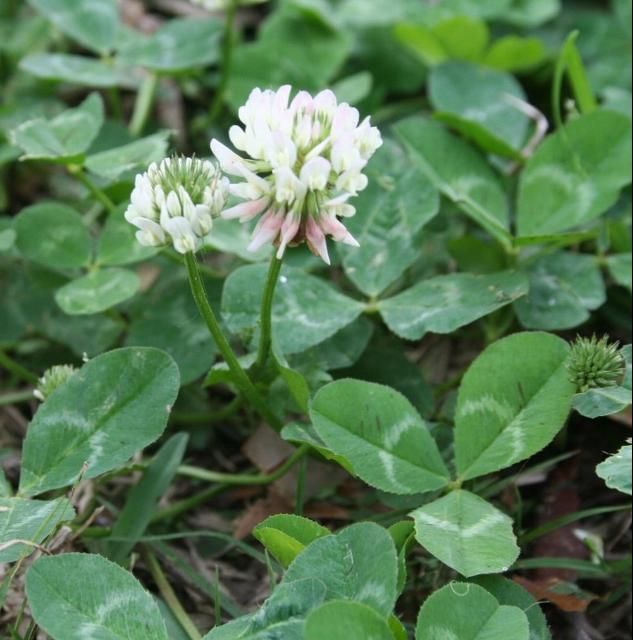
Recommended Varieties (Cultivars)
Two basic types of white clover have been utilized in Florida pastures: large type (ladino) and intermediate type. The most frequently planted cultivars have been Louisiana S-1 (intermediate type) and Osceola (intermediate toward ladino type). Seeds of other cultivars are sometimes available; some of these cultivars include Regal Graze (ladino or large type), and of more recent release, Patriot (intermediate by large type), and Durana (intermediate type). The intermediate types are excellent seed producers for natural reseeding, but plants lack summer persistence. Osceola was developed by UF/IFAS. It has good seed production for a ladino type and improved summer persistence. Several tests have shown Osceola to be higher yielding than Louisiana S-1 and more persistent.
Ocoee white clover is a new release from the University of Florida. Ocoee is an intermediate type with spreading growth habit that has tolerance to southern root-knot nematode (RKN) (Meloidogyne spp). Drought conditions in Florida accentuate the effect of nematodes on clover establishment, production, and persistence. Ocoee was selected from the University of Florida release 'Osceola', and has resistance to multiple RKN species. In studies conducted at the University of Florida, it showed 85% more resistance than 'Osceola'. Similarly, yields were higher for 'Ocoee' (2700 lb/acre) than Osceola (2200 lb/acre) during the 2003–2004 season at the Agronomy Forage Research Unit. Ocoee white clover is an option for farmers with areas that have high nematode populations that negatively impact their yields and add to stand decline. As a white clover, Ocoee is adapted to well-drained soils that have good water holding capacity. Ocoee white clover will fix nitrogen and add to the forage quality of the pasture.
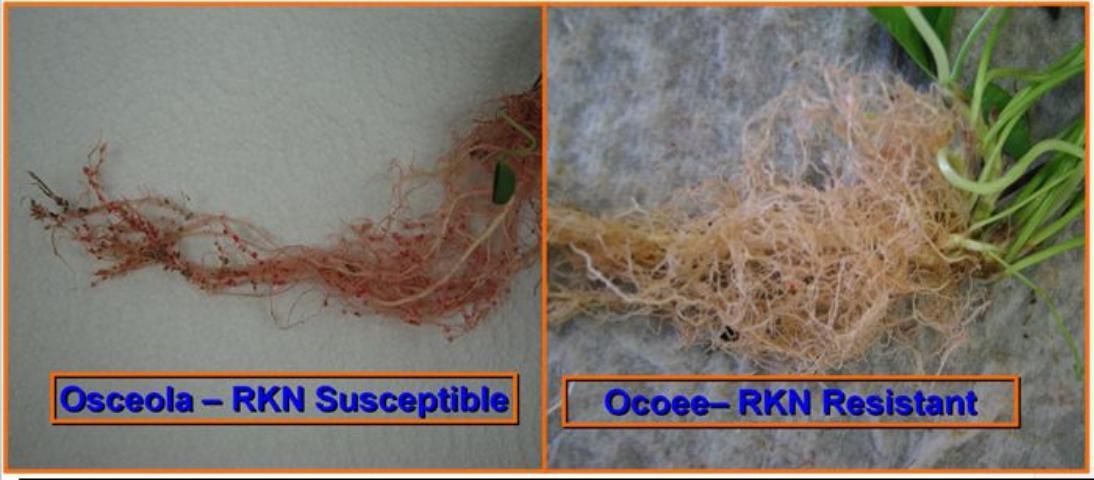
Credit: Ken Quesenberry
White clover variety trials were carried out at two locations: UF/IFAS North Florida Research and Education Center (NFREC) in Marianna (Figure 3) during two seasons (2013–2014 and 2014–2015) and at the Agronomy Forage Unit in Gainesville, during one season (2013–2014). White clover varieties tested included 'Barblanca', 'Crusade', 'Durana', 'FourLeaf', 'Ocoee', 'Osceola', and 'Regal Graze'. Both trials were planted in a randomized complete block design, with four replications per treatment. Each plot measured 6 x 15 feet. In Marianna, clovers were harvested three times in each season (4/21, 5/16, 6/24/2014 and 4/3, 5/7, 6/11/2015) at a two-inch stubble height. In Gainesville, clovers were harvested two times in the 2014 season (4/30 and 6/10/2014) at a two-inch stubble height. In Marianna, white clover total dry matter yield ranged from 3260 to 5160 lb/A in 2014 (Figure 4) and from 1490 to 3060 lb/A in 2015 (Figure 5). In 2014, top white clover varieties included Regal Graze (5160 lb/A), FourLeaf (5030 lb/A), Osceola (4740 lb/A), and Ocoee (4700 lb/A). In 2015, top varieties were Osceola (3060 lb/A), Regal Graze (2920 lb/A), FourLeaf (2700 lb/A), and Ocoee (2530 lb/A). In Gainesville, total dry matter yields ranged from 2870 to 1440 lb/A (Figure 6). At this location the top varieties were FourLeaf (2870 lb/A), Osceola (2700 lb/A), Regal Graze (2670 lb/A), and Ocoee (2480 lb/A). Choice of white clover variety must be based not only on yield, but also on tolerance to root-knot nematode. Ocoee ranked among the top white clover varieties and was selected for its tolerance to root-knot nematode (Meloidogyne spp.), thus making it the best option for areas with nematode infestation.
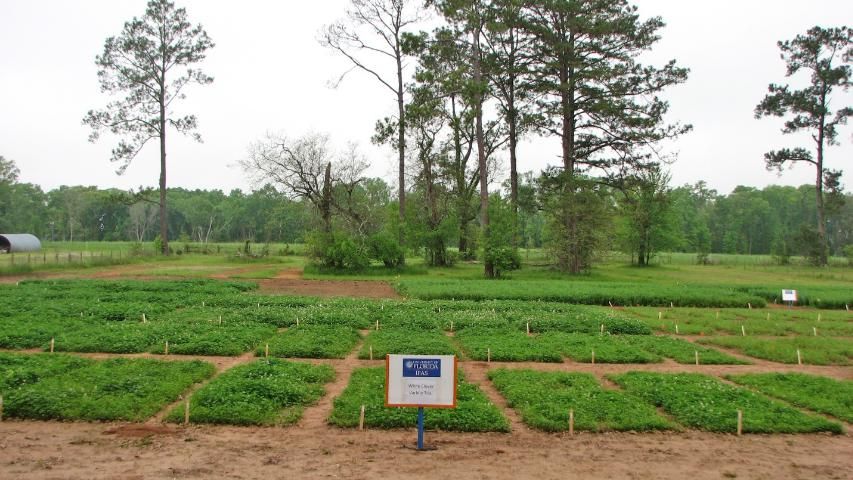
Credit: UF/IFAS
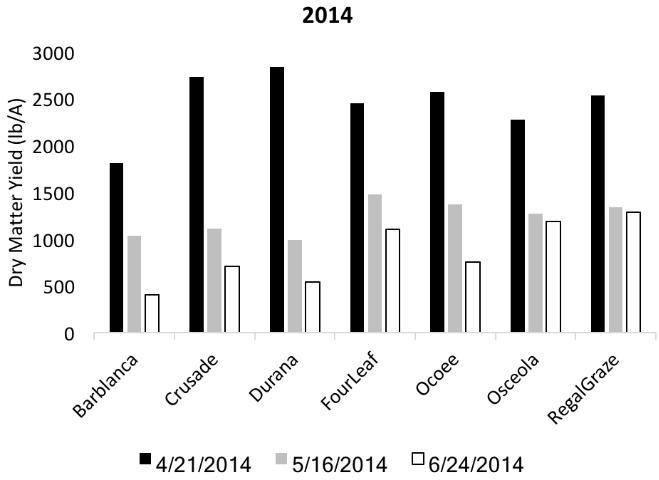
Credit: UF/IFAS

Credit: UF/IFAS
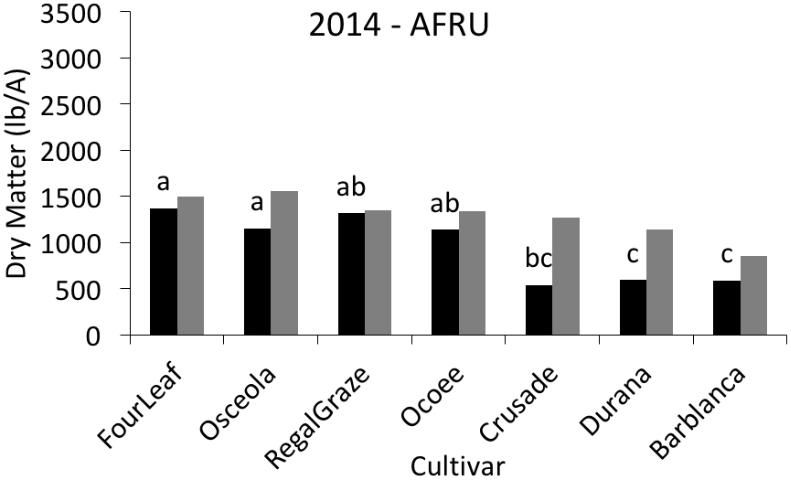
Credit: UF/IFAS
Establishment
White clover grows best under cool temperatures and on fertile soils with excellent and sustained moisture holding capacity. Clay and loam soils of northwest Florida and selected flatwood sites in northeast and peninsular Florida can grow white clover on a fairly consistent basis. Flatwood sites must have sustained soil moisture from October through May to produce white clover. These sites have years with good production and poor production, with good production years occurring when rainfall is above normal. Many of the sites that are suitable for growing white clover already have some white clover present. Older stands of Louisiana S-1 can be overseeded with Osceola to improve production. White clover also can be seeded with ryegrass on a clean-tilled seedbed or into sod. Once a site has been selected for seeding, a soil test should be used to determine the proper amounts and kinds of lime and nutrients needed. Soil pH should be maintained above 6.0 but should not exceed 7.0. Fertilization with 20 to 30 pounds of P2O5 and 50 to 70 pounds of K2O per acre is usually needed on low-fertility flatwoods and should be applied following planting and again in the late fall of each year of production. Good stands with heavy clover production may respond to an additional 60 pounds per acre of K2O in the spring. Micronutrients and sulfur are not generally recommended but might be beneficial at some locations.
White clover should be planted in the fall. Plant between October 15 and November 15. Plantings in north Florida can be made in the early part of the planting season, with plantings in south Florida being made during the last half of the season. Planting in December can be risky, especially in north Florida, because complete loss of a stand from severe freezes (below 25°F) during the seedling stage can occur.
Also, late plantings usually result in later forage production in the spring and lower total production.
Most white clover will be planted into an existing grass sod. Prior to planting, the grass should be mowed or grazed to reduce competition with the clover seedlings. Harvest bahiagrass, by mowing or grazing, to a height of 2 inches or less and other improved grasses to 4 inches. A light disking or chopping is beneficial, especially on bahiagrass sods, to reduce competition and ensure good seed-soil contact.
White clover seed should be inoculated with the correct strain of Rhizobium bacteria just before planting. With adequate nodulation, the need for a nitrogen fertilization is eliminated. When planting into a pasture that already has inoculated white clover growing in it, inoculation of the seed will not be necessary. Plant 3 to 4 pounds of seed per acre and then go over the land with a cultipacker or land-roller to firm the seedbed and obtain good seed to soil contact. With good soil moisture and warm weather, the perennial pasture grass may continue growing; this will require grazing to reduce the competition of the grass with the white clover seedlings. Continue grazing the grass before any damage to the clover seedlings from trampling or grazing occurs. At this time, remove animals and let the clover or ryegrass-clover develop to a height of 6 to 10 inches before grazing.
Management Recommendations
Grazing
Large pastures of white clover should be divided and rotationally grazed (stocked) with cow-calf pairs or with developing heifers. Small acreages can be limit-grazed and/or creep-grazed. In order to use the white clover as a protein and energy supplement, the cows can be allowed to graze only 1 to 2 hours each day. This will allow for optimum utilization of the white clover pasture.
Irrigation
When it is cost effective, irrigation will ensure maximum production and prevent loss of stand due to a late spring drought.
Reseeding
Livestock should be removed or grazing pressure reduced during the time of maximum seed production. Reduced grazing pressure should last for 2 to 3 weeks to allow some seed to mature.
Summer Survival
To help Osceola clover plants live through the summer, the pasture grass should be harvested by mowing or grazing to a 2- to 4-inch height every 4 to 6 weeks during the summer. This will prevent the clover plants from being weakened or killed by shading.
Fall Regrowth
Clover regrowth both from stolons (summer live-over plants) and seed is again dependent on controlling grass competition. This is best done through grazing; however, mowing the grass to a 2- to 3-inch height in late September and October will be helpful if close grazing is not possible. Apply fertilizer after removing the grass. Irrigate if possible and if needed to encourage rapid development of the clover and earlier grazing.

Credit: UF/IFAS

Credit: UF/IFAS

Credit: UF/IFAS

Credit: UF/IFAS
Postscript
Occasionally someone complains that white clover just does not grow as well as it did in the 1940s and 1950s. This is probably true in many instances. It is now thought that populations of certain nematodes and viral diseases that adversely affect white clover growth have increased over the years. Also, there may be more drainage ditches than there once were, thus increasing drought stress, and irrigation is less available than it once was. All of the factors add up to less white clover. Yet, many producers still successfully grow white clover by carefully selecting those sites that have the best chance of remaining moist throughout the fall, winter, and spring.